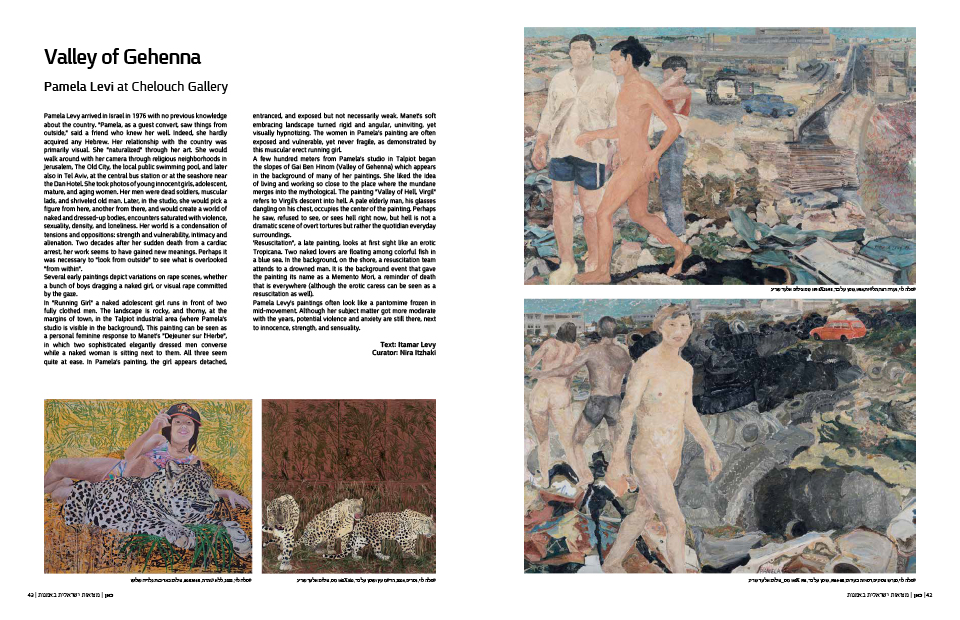
| Home Page | Editor Notices | Museums | Galleries | Publication | Donation | Contact Us |


 | |||||||||||||||
| |||||||||||||||


| |||||||||||||||
| Pamela Levi at Chelouch Gallery |
Pamela Levy arrived in Israel in 1976 with no previous knowledge about the country. "Pamela, as a guest convert, saw things from outside," said a friend who knew her well. Indeed, she hardly acquired any Hebrew. Her relationship with the country was primarily visual. She "naturalized" through her art. She would walk around with her camera through religious neighborhoods in Jerusalem, The Old City, the local public swimming pool, and later also in Tel Aviv, at the central bus station or at the seashore near the Dan Hotel. She took photos of young innocent girls, adolescent, mature, and aging women. Her men were dead soldiers, muscular lads, and shriveled old man. Later, in the studio, she would pick a figure from here, another from there, and would create a world of naked and dressed-up bodies, encounters saturated with violence, sexuality, density, and loneliness. Her world is a condensation of tensions and oppositions: strength and vulnerability, intimacy and alienation. Two decades after her sudden death from a cardiac arrest, her work seems to have gained new meanings. Perhaps it was necessary to "look from outside" to see what is overlooked "from within". Several early paintings depict variations on rape scenes, whether a bunch of boys dragging a naked girl, or visual rape committed by the gaze. In "Running Girl" a naked adolescent girl runs in front of two fully clothed men. The landscape is rocky, and thorny, at the margins of town, in the Talpiot industrial area (where Pamela's studio is visible in the background). This painting can be seen as a personal feminine response to Manet's "Dejeuner sur l'Herbe", in which two sophisticated elegantly dressed men converse while a naked woman is sitting next to them. All three seem quite at ease. In Pamela's painting, the girl appears detached, entranced, and exposed but not necessarily weak. Manet's soft embracing landscape turned rigid and angular, uninviting, yet visually hypnotizing. The women in Pamela's painting are often exposed and vulnerable, yet never fragile, as demonstrated by this muscular erect running girl. A few hundred meters from Pamela's studio in Talpiot began the slopes of Gai Ben Hinom (Valley of Gehenna) which appears in the background of many of her paintings. She liked the idea of living and working so close to the place where the mundane merges into the mythological. The painting "Valley of Hell, Virgil" refers to Virgil's descent into hell. A pale elderly man, his glasses dangling on his chest, occupies the center of the painting. Perhaps he saw, refused to see, or sees hell right now, but hell is not a dramatic scene of overt tortures but rather the quotidian everyday surroundings. 'Resuscitation", a late painting, looks at first sight like an erotic Tropicana. Two naked lovers are floating among colorful fish in a blue sea. In the background, on the shore, a resuscitation team attends to a drowned man. It is the background event that gave the painting its name as a Memento Mori, a reminder of death that is everywhere (although the erotic caress can be seen as a resuscitation as well). Pamela Levy's paintings often look like a pantomime frozen in mid-movement. Although her subject matter got more moderate with the years, potential violence and anxiety are still there, next to innocence, strength, and sensuality. Text: Itamar Levy Curator: Nira Itzhaki Read more  |
| all rights reserved - CAN ISRAELI ART REALITY |
| סייבורג מחשבים - בניית אתרים |